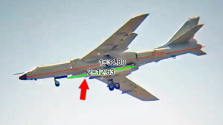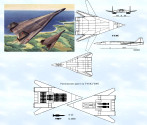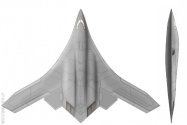This could also explain the delayed rollout of the H20Understood.
In that case, and considering the push for heavy bombers in the PLAAF as mentioned - If these new missiles are expected to grow so big and so heavy such that the H-6K/J/Ns are unable to carry more than one of them per plane using the underwing pylons, and that carrying only one missile underneath the belly of the aircraft:
One or two (parallel) 10+ meter-long IWBs on the H-20 will (not would) become unavoidable, in this case. This means that the H-20 will have to be considerably longer than the B-2, let alone the B-21. This would also exclude pure flying wing designs with shallower wing sweep angles like the ones found on the B-2 and B-21, otherwise the H-20 would become too massive.
Therefore, the H-20 would be considerably large - Larger than the B-2. Estimated overall dimension could be somewhere around the Tu-22M and B-1B in extended wing configurations (if not wider), whereas the estimated MTOW could be somewhere around the B-1B (~220 tons). High-subsonic-capable only, given the massive combat radius and payload capacity required for the H-20's expected mission set.
Of course, this is only my own interpretation and deduction on the matter, given the limited information available on the H-20 so far.
You are using an out of date browser. It may not display this or other websites correctly.
You should upgrade or use an alternative browser.
You should upgrade or use an alternative browser.
H-20 bomber (with H-X, JH-XX)
- Thread starter Deino
- Start date
The hilarious thing is that nickname for H-6N and ALBM combinations that it could use originated from this article:Ähhhm ... what missile did I miss?
Which has the quote:

That article actually came out (September 2020) before we got the photo of H-6N actually carrying an ALBM in October that same year:
Then several days later Xiyazhou made a video with "Beijing's Hammer" in the title and since then that nickname has become popular:
Last edited:
Discussion continued here to avoid derailing original thread.
Speaking of which, I made some rough measurements based on this H-6N carrying a supersized HGV missile at its centerline, indicating said HGV missile being about 13 meters long (discrepancies included).

Hence, for the unknown target missiles that are longer/larger than the YJ-20/21 (~8.5 meters long) and smaller/shorter than the above missile (~13 meters long) - These missiles should be somewhere between 9 and 12 meters long. Maybe 10 - 11 meters?
Hence, given that the H-20 is intended to not just carry such target missiles, but being able to carry a pair of said missiles or more - This would call for one pretty long (~10-12 meters?) and wide IWB, or two similarly long but narrower IWBs arranged side-by-side on the H-20.
Shilao and co mentioned that all that development in HCM has made PLAAF realize the need for a new bomber. There's a new class of weapon that's too big for H-6 to carry a pair of ala YJ-21, yet too small and not strategic weapon enough to make it a H-6N centerline special. Thus PLAAF now has a clear use case to argue for a new larger bomber.
Yeah, we've been discussing this in the H-20 thread. But I wonder if they mean the H-20 is designed with this in mind or there is a need for a B-52 class bomber or something even larger
Speaking of which, I made some rough measurements based on this H-6N carrying a supersized HGV missile at its centerline, indicating said HGV missile being about 13 meters long (discrepancies included).

Hence, for the unknown target missiles that are longer/larger than the YJ-20/21 (~8.5 meters long) and smaller/shorter than the above missile (~13 meters long) - These missiles should be somewhere between 9 and 12 meters long. Maybe 10 - 11 meters?
Hence, given that the H-20 is intended to not just carry such target missiles, but being able to carry a pair of said missiles or more - This would call for one pretty long (~10-12 meters?) and wide IWB, or two similarly long but narrower IWBs arranged side-by-side on the H-20.
Last edited:
This long IWB being the objective surely it would make sense for H-20 to not just be a scaled up B-2 but a different shape that would fit that requirement better?Speaking of which, I made some rough measurements based on this H-6N carrying a supersized HGV missile at its centerline, indicating said HGV missile being about 13 meters long (discrepancies included).
View attachment 158935
Hence, for the unknown target missile that is longer/larger than the YJ-20/21 (~8.5 meters long) and smaller/shorter than the above missile (~13 meters long) - This missile should be somewhere between 9 and 12 meters long. Maybe 10 - 11 meters?
Hence, given that the H-20 is intended to not just carry such target missile, but being able to carry a pair of said missiles or more - This would call for one pretty long (~10-12 meters?) and wide IWB, or two similarly long but narrower IWBs arranged side-by-side on the H-20.
Many years ago Xiyazhou suggested it could instead be in the shape of T-4MS:

But with more focus on stealth and no swing wing. Given this particular elongated delta-wing shape is currently in vogue with 6th gen fighter prototypes and can benefit from all the aerodynamic work already done on it perhaps the probability of H-20 looking like this is increasing?
Xiyazhou's original video:
This long IWB being the objective surely it would make sense for H-20 to not just be a scaled up B-2 but a different shape that would fit that requirement better?
Many years ago Xiyazhou suggested it could instead be in the shape of T-4MS:
But with more focus on stealth and no swing wing. Given this particular elongated delta-wing shape is currently in vogue with 6th gen fighter prototypes and can benefit from all the aerodynamic work already done on it perhaps the probability of H-20 looking like this is increasing?
Xiyazhou's original video:
In the meantime, based on the aforementioned descriptions, I do expect something resembling this (or a less radical, cranked kite flying wing design variation of this), taken from the PS/CG thread:

Sure, the overall VLO capability would take a hit - But if it's primary tasks are to lob standoff hypersonic missiles against the enemy targets at 1000s of kilometers away, then it should be an acceptable tradeoff.
And again - I don't think going anywhere beyond high-subsonic is a good idea, given the range requirements for the H-20 in order to fulfill its mission sets.
Last edited:
But arguing against this, if your only mission is to lob super long-range missiles at enemies from behind friendly lines then why need stealth at all? I'm pretty sure that's the basic idea that has kept B-52s in service for so long. H-20 should do its own mission ie penetrating advanced air defenses to strike deep into enemy territory while leaving the lobbing large missiles to something else.In the meantime, based on the aforementioned descriptions, I do expect something resembling this (or a less radical, cranked kite flying wing design variation of this), taken from the PS/CG thread:
View attachment 158939
Sure, the overall VLO capability would take a hit - But if it's primary tasks are to lob standoff hypersonic missiles against the enemy targets at 1000s of kilometers away, then it should be an acceptable tradeoff.
And again - I don't think going anywhere beyond high-subsonic is a good idea, given the range requirements for the H-20 in order to fulfill its mission sets.
Hypothetically speaking, there is a divergence in operation between the clear distinct roles. The faster aircraft that isn't for penetrating but for launching long range, high speed weapons at speed and altitude but under protection of major volume of airborne assets would not need to be anywhere near as stealthy as the subsonic ULO (ultra low observable) bomber that we assume H-20 fills.
A JH-xx absolutely is a different beast. If China has two upcoming bombers - they will be different enough and designed around the abovementioned roles. Previous speculation on this forum over the years has indicated a cancellation of JH-xx with role sort of absorbed by H-20 leading some speculation on H-20's redesign to a supersonic stealth bomber. It's probably easier to have a ULO subsonic bomber and a separate LO bomber that can be the updated H-6 but supersonic. The trade off for stealth would be speed and payload volume.
A JH-xx absolutely is a different beast. If China has two upcoming bombers - they will be different enough and designed around the abovementioned roles. Previous speculation on this forum over the years has indicated a cancellation of JH-xx with role sort of absorbed by H-20 leading some speculation on H-20's redesign to a supersonic stealth bomber. It's probably easier to have a ULO subsonic bomber and a separate LO bomber that can be the updated H-6 but supersonic. The trade off for stealth would be speed and payload volume.
Ultimately splitting roles is in a sense a workaround for cost and powerplant limits. If you can ensure sufficiently powered engines at a reasonable cost you don’t need to split roles, especially if lower performance roles can simply be offloaded to lower cost unmanned platforms.Hypothetically speaking, there is a divergence in operation between the clear distinct roles. The faster aircraft that isn't for penetrating but for launching long range, high speed weapons at speed and altitude but under protection of major volume of airborne assets would not need to be anywhere near as stealthy as the subsonic ULO (ultra low observable) bomber that we assume H-20 fills.
A JH-xx absolutely is a different beast. If China has two upcoming bombers - they will be different enough and designed around the abovementioned roles. Previous speculation on this forum over the years has indicated a cancellation of JH-xx with role sort of absorbed by H-20 leading some speculation on H-20's redesign to a supersonic stealth bomber. It's probably easier to have a ULO subsonic bomber and a separate LO bomber that can be the updated H-6 but supersonic. The trade off for stealth would be speed and payload volume.
But arguing against this, if your only mission is to lob super long-range missiles at enemies from behind friendly lines then why need stealth at all? I'm pretty sure that's the basic idea that has kept B-52s in service for so long. H-20 should do its own mission ie penetrating advanced air defenses to strike deep into enemy territory while leaving the lobbing large missiles to something else.
Because there will be chances where the H-20 would still have no choice but to fly through contested airspaces and/or over enemy-controlled territories where the enemy's aerial and surface-based IADS is still active, even as the PLAAF pilots, mission controllers and planners have zero intention of doing so.
In fact, it is absolutely impossible to guarantee that the H-20 would fly through airspaces that is completely free of enemy airborne and surface IADS assets, 100% of the time. Things can change for the best or worst at an instant on the battlefield pf today and going forward.
Hence, having at least certain degree of VLO capability as an option to rely upon is still very much better (and safer) than not having any at all.
Last edited:
Stealth (penetration and survivability), speed (imparting energy and time to target), payload (volume and weight), Agility.
Four parameters to compromise. J-36 compromises out payload and some agility. J-50 compromises out payload to a greater degree. H-20 would compromise out speed and agility. JH-xx or non-stealth supersonic bomber as Beijing Hammer 2.0 would compromise out agility and stealth.
There's definitely other attributes to having a two platforms. It's a workaround on cost and powerplant limits to only a slight degree. No aircraft has all four in spades. B-21 compromises out payload (relative to B-2 H-20 and JH-xx), agility, and speed.
5th parameter is cost but J-36 is probably the only aircraft in the world that gets closest to the highest coverage. It has all of them to some decent degree but more payload than most fighters, similar speed, higher stealth, lower agility.
A hypothetical complementing bomber that is less stealthy or non-stealthy but supersonic and can carry at least 2 ALBMs, ALHGV, ALHCM would be also useful in other ways that H-20 isn't. Time to target and imparting energy. Having those two platforms simultaneously means all three major categories are covered (no bomber is going to be agile).
Four parameters to compromise. J-36 compromises out payload and some agility. J-50 compromises out payload to a greater degree. H-20 would compromise out speed and agility. JH-xx or non-stealth supersonic bomber as Beijing Hammer 2.0 would compromise out agility and stealth.
There's definitely other attributes to having a two platforms. It's a workaround on cost and powerplant limits to only a slight degree. No aircraft has all four in spades. B-21 compromises out payload (relative to B-2 H-20 and JH-xx), agility, and speed.
5th parameter is cost but J-36 is probably the only aircraft in the world that gets closest to the highest coverage. It has all of them to some decent degree but more payload than most fighters, similar speed, higher stealth, lower agility.
A hypothetical complementing bomber that is less stealthy or non-stealthy but supersonic and can carry at least 2 ALBMs, ALHGV, ALHCM would be also useful in other ways that H-20 isn't. Time to target and imparting energy. Having those two platforms simultaneously means all three major categories are covered (no bomber is going to be agile).
